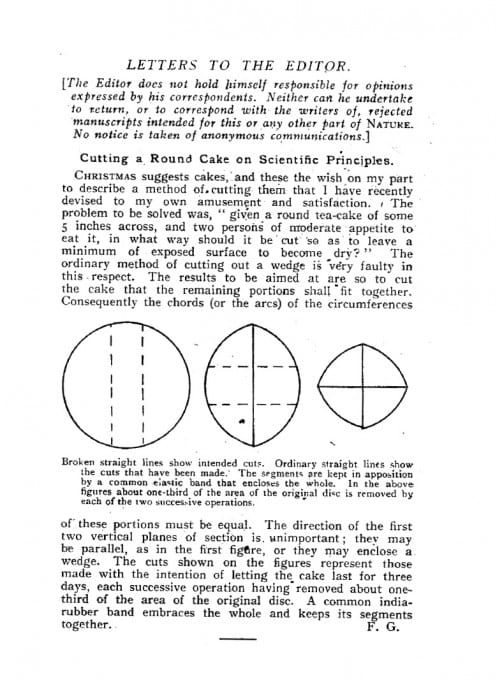Murphy’s law
By ucapjo0, on 9 February 2015
Jonathan Oppenheim has co-authored a new paper on quantum thermodynamics, which can be read here.
You’re probably familiar with the second law of thermodynamics in one of its many forms:
Anything that can possibly go wrong, does.
— Murphy’s law
“Happy families are all alike; every unhappy family is unhappy in its own way.”
— Leo Tolstoy in Anna Karenina, almost 20 years before Boltzmann’s Kinetic Theory of Gases
Shit happens
— ancient proverb
Because every day we feel the consequences of the second law. Even Homer Simpson has been known to admonish his children: “In this house, we obey the laws of thermodamynics!” Not that Bart or Lisa would have much choice. The second law of thermodynamics governs much of the world around us – it tells us that a hot cup of tea in a cold room will not spontaneously heat up; it tells us that unless we are vigilant, our homes will become untidy rather than tidy; it tells us how efficient the best engines can be and even helps us distinguish the direction of time – we see vases shatter, but unless we watch movies backwards, never see the time-reverse – a shattered vase reforming with just a nudge.
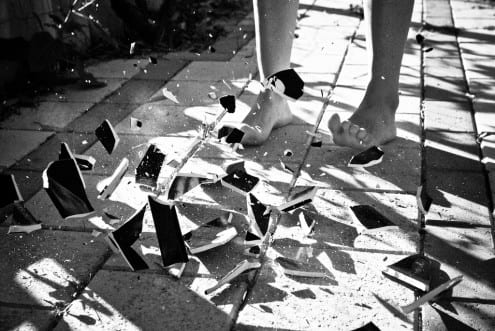
Vases do not spontaneously unbreak themselves. Photo: Drew Bandy (CC BY NC SA)
The second law tells us that order tends towards disorder, something we are all very familiar with — trying to achieve a very specific state of affairs can be very difficult, because there are many different ways things can go wrong. Murphy’s Law (anything that can go wrong, will go wrong), is a reasonable statement of the second law of thermodynamics. As is its less precise version “Shit happens”.
More concretely, the second law tells us that for isolated systems, the entropy, a measure of disorder, can only increase. I like to think of the second law as constraining what can happen to a system — left on its own, things don’t get more ordered.
But the laws of thermodynamics only apply to large classical objects, when many particles are involved. What do the laws of thermodynamics look like for microscopic systems composed of just a few atoms? That laws of thermodynamics might exist at the level of individual atoms was once thought to be an oxymoron, since the laws were derived on the assumption that systems are composed of many atoms.
Are there even laws of thermodynamics at such a small scale?
The question is becoming increasingly important, as we probe the laws of physics at smaller and smaller scales.
Statistical laws apply when we consider large numbers. For example, imagine we toss a coin thousands of times. In this case, we expect to see roughly equal numbers of heads as tails, while the chance that we find all the coins landing heads is vanishingly small. If we imagine tossing a larger and larger number of coins, the chance of having an anomalous coin tossing such as all tails goes to zero and our confidence that we’ll have roughly half heads, half tails, increases until we are virtually certain of it.
However, this is not true when tossing the coin just a few times. There’s a reasonable chance we will find all the coins landing tails. So, can we say anything reasonable in such a case? Similar phenomena occur when considering systems made out of very few particles, instead of very many particles. Can we make reasonable thermodynamical predictions, about systems which are only made up of a few particles.
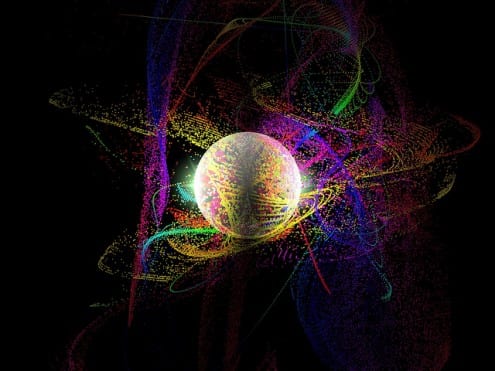
Can we even talk about the laws of thermodynamics when we’re only looking at a handful of particles? Picture credit: Stef Simmons (CC BY)
Surprisingly, the answer is yes, and the mathematical tools from a field known as quantum information theory help us to understand the case when we don’t have a large number of particles. What we find, is that not only does the second law of thermodynamics hold for quantum systems, and those at the nano-scale, but there are even additional second laws of thermodynamics. In fact, there is an entire family of second laws. So, while Murphy’s law is still true at the quantum scale — things will still go wrong; the ways in which things go wrong is further constrained by additional second laws. Because remember, the second law is a constraint, telling us that a system can’t get more ordered. These additional second laws, can be thought of as saying that there are many different kinds of disorder at small scales, and they all tend to increase as time goes on. What we find is a family of other measures of disorder, all different to the standard entropy, and they must all increase.
This means that fundamentally, there are many second laws, all of which tell us that things become more disordered, but each one constrains the way in which things become more disordered. Why then does there only appear to be one second law for large classical systems? That’s because all the second laws, although different at microscope scales, become similar at larger scales. At the scale of the ordinary objects we are used to, all the quantum second laws are equal to the one we know and love.
What’s more, it can sometimes happen that the traditional second law can appear to get violated – quantum system can spontaneously become more ordered, while interacting with another system which barely seems to change. That means some rooms in the quantum house may spontaneously become much tidier, while others only become imperceptibly messier.
What do these additional second laws look like? Well, first let’s get a bit more technically dirty. If you already know your thermodynamics fairly well, this is a good point to join us. For those who’ve had enough, here is a picture of Watt’s steam engine. It’s big enough that none of these additional second laws matter.
Twinkle: a new mission to study distant planets
By Oli Usher, on 9 February 2015

Twinkle. Credit: SSTL/Twinkle/DSS
A new satellite for observing extrasolar planets could be in orbit within four years, under plans drawn up by UCL and Surrey Satellite Technology Limited (SSTL). The Twinkle satellite, pictured above, will observe the light of distant stars with planets orbiting them.
As a planet passes between the star and Twinkle’s telescope, a small amount of the light passes through its atmosphere, imprinting on it the chemical signature of its atmosphere. This technique has been used by Hubble to analyse the atmospheres of a handful of exoplanets, but the Twinkle team hopes to probe at least 100 during the spacecraft’s mission.
UCL leads a consortium of UK institutes who will construct Twinkle’s scientific instrumentation, a highly precise infrared spectrometer which can tease out the faint signature of the planetary atmospheres from the starlight.
Links
High resolution image
Asteroid’s close encounter with Earth – the UCL view
By Oli Usher, on 2 February 2015

Last week, asteroid 2004 BL86 passed near Earth. The ball of rock, a little over 300 metres across, passed 3.1 lunar distances from Earth.
This is far enough not to be of any serious concern – but it is closer than any other known asteroid will come to us until 2027. If an asteroid like 2004 BL86 were to hit Earth, we could expect widespread destruction – the famous Barringer Crater in Arizona was gouged out by an object just 50 metres across.
During its close approach, UCL’s observatory spotted the asteroid and snapped the picture above: a series of 30 second exposures separated by 9 second gaps. The asteroid can be seen moving rapidly against the background stars as the telescope was programmed to track the movement of the stars.
Reprogramming the telescope to hold the asteroid in its sights creates the image below – with the stars appearing as streaks instead.

This video, featuring a series of observations of the asteroid made at the observatory over the night of 26-27 January, shows both types of observation, including a long shot tracking the asteroid across the sky.
Images by Steve Fossey, Theo Schlichter and Ian Howarth.
Links
High resolution image
Hinode spacecraft: near encounters with space debris
By ucaslkh, on 27 January 2015
The life of a spacecraft can be a difficult one. It’s made even more challenging with the amount of space debris that exists. The debris comes from a range of sources – mainly old satellites and rocket stages.
Using radar techniques the debris is monitored, with over 22,000 pieces that are bigger than 10 cm wide currently being tracked.
There are probably millions of bits smaller than this that can also cause damage.

Hinode was launched in 2006, and had previously made one spacecraft manoeuvre to avoid debris. This was back in March 2012.
This debris-avoidance manoeuvre (known as a DAM) involved changing the orbit of the spacecraft by using the thrusters. The instruments onboard were put into a safe mode and stopped operating during this time.
In January 2015, preparations were made for a possible DAM on 19 January, but as the time approached it was possible to cancel the DAM as the collision probability became low enough as the orbit prediction was revised.
On 26 January another piece of debris was deemed to have a high risk of collision and the DAM was set into motion. The instruments were put into safe mode and stopped operating over the weekend. The spacecraft did not have to carry out the manoeuvre in the end, and after the close encounter the spacecraft was safe and is in its usual orbit.
The instruments will start operating normally once again on 29 January.
Space debris is an ongoing and increasing problem, and no doubt more of these alerts will be coming in future.
- Louise Harra is Professor of Solar Physics at UCL, and is the UK scientific leader on the Hinode Extreme Ultraviolet Imaging Spectrograph, part of the Japanese/US/UK Hinode spacecraft
A molecule-sized magnetic sensor
By Oli Usher, on 26 January 2015
This image shows a scanning tunnelling microscope (STM) image of a molecule of iron phtalocyanine, separated from an underlying layer of copper by a thin barrier of copper nitride.
The image is part of a new piece of research just published by UCL scientists. The iron phtalocyanine molecule forms part of a tiny magnetic sensor which is sufficiently sensitive that it can detect molecule-sized magnetic fields. This technology could allow far smaller hard disks and new computer memory designs.
Links
High resolution image
Not waving
By uccafau, on 19 January 2015
By 2050, London is likely to be severely in drought. The cause is a combination of growing population, the way we use water and pipe it around our cities and towns, and climate change. If we carry on as we are, there will be a deficit amounting to the water use of 2 million people in a short few decades. On the other hand, risks of water related natural disasters are set to increase, particularly the likelihood of large parts of the UK submerging if all Arctic ice melts. It’s the same story around the globe.
We know all this, and yet as a species we are doing little to address the problem. We protest, we raise awareness, but overall we are still heading for a vastly altered world.
This week, I’m exhibiting my sculpture Not Waving at The Crystal in East London, as part of New Atlantis, an immersive theatre production from LAStheatre. Consisting of 100 miniature people atop 3 miniature icebergs in a bath, an urn and a lot of clever electronics, this interactive installation determines the micro-people’s fate dependent on how much we are chattering about #water on Twitter. Tweet enough and they may survive the show, but if there isn’t enough chatter, water is released from the urn above them – they are drenched and doomed.
The icebergs are made of between 3 and 6 litres of water, which takes quite a while to freeze. Preparations for the sculpture began back in late November, when I started making the moulds for the icebergs with the help of prop-maker Ben Palmer. Once the moulds were ready, I brought them to UCL’s Ice Physics lab where the icebergs were frozen over the course of the last 2 months by Ben Lishman, of UCL’s Institute for Risk and Disaster Reduction, who’s also appearing in the show.

Next came the electronics – a Raspberry Pi and servo hacked into a water urn. This rig talks to the internet and controls the urn’s tap, releasing water when there has been insufficient tweeting about #water. What’s insufficient? Well, I worked out an average number of tweets per 10 minutes across an evening, and set it at just above that mark – 50 per 10 minutes. This is all connected up to a screen, programmed with the help of Jun Matsushita to look like this:
 Of course, the secret is that the fate of our 100 micro-people is sealed: the urn will empty into the bath at the end of the show. Because it turns out social media chatter doesn’t change our fate – we need to act here in the physical, real world. The one in which the water is wet, the ice is melting, and the little people are struggling to stay dry.
Of course, the secret is that the fate of our 100 micro-people is sealed: the urn will empty into the bath at the end of the show. Because it turns out social media chatter doesn’t change our fate – we need to act here in the physical, real world. The one in which the water is wet, the ice is melting, and the little people are struggling to stay dry.
 That’s the reason the drowning is staged in a bath, with a hot-water urn above it, and tweets scrolling on a screen above that. All these activites – heating and processing water, and our endless online activity – they have a carbon footprint. They are all contributing to climate change.
That’s the reason the drowning is staged in a bath, with a hot-water urn above it, and tweets scrolling on a screen above that. All these activites – heating and processing water, and our endless online activity – they have a carbon footprint. They are all contributing to climate change.

Happily, we aren’t at the end of the show yet – and New Atlantis gives the audience the opportunity to learn about how we might deal with water stress in the future – and make decisions within the world of New Atlantis about how we might move forward.
Lots of the details of production are on my blog, and if you’re thinking of doing something similar I’d be very happy to tell you more of what I’ve learned. I also explain a bit more about it in this interview for iScience.
If you’d like to check it out, New Atlantis runs until the 25th January at The Crystal.
Kat Austen is Artist in Residence at UCL Faculty of Mathematical & Physical Sciences
Related links
10 Questions
By ucqndko, on 16 January 2015
The Institute of Biomedical Engineering (IBME) interviews our researchers, academics, students, clinicians, affiliates and partners to find out a little more about who they are and what they do.
This month we speak to Professor Alister Hart, Chair of Academic Clinical Orthopaedics, UCL, Consultant Orthopaedic Surgeon and Director of Research and Development, Royal National Orthopaedic Hospital, about his career, life and favourite pastimes.
 1. What is your job title?
1. What is your job title?
Chair of Academic Clinical Orthopaedics at UCL, Consultant Orthopaedic Surgeon and Director of NHS Research and Development at the Royal National Orthopaedic Hospital (RNOH).
2. What keywords would you pick to describe your work?
Orthopaedic implants, clinical outcome, imaging, blood metal biomarkers for implant function.
3. What brought you to the world of science/engineering/medical technologies/medicine?
I was first really inspired by science at school by my S-level chemistry teacher. I was introduced to the RNOH at around the same time when I used the RNOH library (I went to school locally in Watford) to research my biology A-level project, testing the strength of rat and rabbit tendons. Medicine became the only subject I wanted to do, and I always wanted to be a surgeon.
After school, I continued to be inspired by science via the small group supervision system provided by my Cambridge college, Gonville and Caius. This provided regular weekly discussions with world-leading medical researchers and scientists. The fellows at Caius included Sir Francis Crick, Prof Stephen Hawking, and the current master Professor Sir Alan Fersht (who also happens to now be my father-in law!) so the college had no difficulty in attracting the best teachers.
Interactive discussion of science continued during my MD, which I undertook whilst continuing in my training post as a specialist registrar in orthopaedic surgery. The direct relevance of my research to my clinical training enabled me to do both concurrently. I realised this was how I wanted to continue working throughout my career.
4. What is your favourite thing about your work?
Watching and encouraging the development of the young people in my research group.
5. What’s been your career highlight?
Publishing a paper in Nature when I was a SHO.
6. What is your favourite quote?
“I have not had time to prepare a short speech” by Winston Churchill.
7. Who has been your greatest mentor and why?
My wife. She is a cancer doctor at UCLH with a PhD and two young children. She keeps me grounded by telling me that a cancer diagnosis is much more devastating than arthritis, and academic orthopaedics is an oxymoron. She is much cleverer than me so I listen.
8. What do you do in your spare time?
I do whatever my wife tells me! Actually, I manage to sneak out to keep fit. In the last 3 years I have led expeditions in 5 continents, completed a quadrathlon, two road marathons (including NY), and two cross-country ski marathons.
9. What’s your favourite book at the moment?
How to make an impact by Jon Moon because my life is dominated by anything to do with getting my research ideas disseminated. One day I will return to stories of adventures in wild places.
10. If you had a superpower, what would it be and why?
My superpower would be grant-writing! Then I could spend more time doing sport.
Professor Alister J Hart is Chair of Academic Clinical Orthopaedics, UCL, Consultant Orthopaedic Surgeon and Director of Research and Development, Royal National Orthopaedic Hospital, and Visiting Professor, Imperial College London. His interests focus on the achievement of the best possible patient and radiological outcomes after hip and knee replacement, through implant design, surgical positioning and patient factors. He is co-founder of the London Implant Retrieval Centre (LIRC) with John Skinner, and has published more than 70 papers, and performed more than 3000 operations including 750 primary or revision hip and knee replacements.
The cleanroom at LCN
By Oli Usher, on 12 January 2015
 Labs are rarely spotless. They are working spaces, busy with people. They are difficult to clean. They are also often home to some pretty messy scientific research. In fact, labs often look more like a workshop or garage than they do the gleaming white rooms we see on TV.
Labs are rarely spotless. They are working spaces, busy with people. They are difficult to clean. They are also often home to some pretty messy scientific research. In fact, labs often look more like a workshop or garage than they do the gleaming white rooms we see on TV.
One glaring exception to this is the cleanroom at the London Centre for Nanotechnology. This lab is home to work that would be damaged even by tiny amounts of dust.
For instance, in the photolithography section (above), scientists use light to etch nanoscale circuits and patterns onto silicon surfaces, a process used to make electronic components. Even a speck of dust could derail this by casting a shadow on the surface and ruining the pattern.
For the same reason, the room is lit only with orange light. The light used to etch the surfaces is closer to the blue end of the visible spectrum, and any stray blue light could ruin the process. The distinctive lighting in the room avoids any inadvertent damage being caused to the experiment.
Links
High resolution image
Mauna Kea diary
By ucapowe, on 7 January 2015
Amidst the indescribable stress that is writing up my PhD, there is a massive silver lining. I’m currently writing this from 2,800m (that’s about 9,200 feet), half way up the Mauna Kea volcano in Hawaii. I say volcano, it’s not actually erupted for several thousand years and (the reason that I’m here) it has billions of pounds worth of massive telescopes on top of it.

The peak of Mauna Kea, with Subaru, Keck 1, Keck 2 and NASA IRTF telescopes. Photo: Alan L (CC BY)
During the second year of my PhD, my supervisors and I, whilst looking at some data everyone had assumed was assumed was empty, discovered the first molecule containing a noble gas in it in space. Those of you who know anything about Chemistry will know this is really weird. Noble gasses are so named because they’re noble: they don’t mix with the other elements.
However, in the remnants of a star that exploded around 1000 years ago, the conditions for it to actually do so happened. This is a massive deal and needs following up quickly – which as well as taking over a substantial chunk of my time over the past year has now brought me to Hawaii.
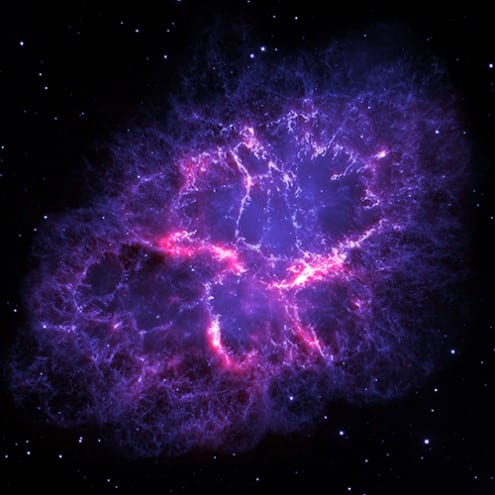
The Crab Nebula – where UCL researchers discovered argon hydride molecules. Photo credit: NASA/ESA/Hester/Loll/Barlow
Last night was my first trip up to the summit, where I spend several hours at NASA’s Infrared Telescope Facility. It’s an odd experience being that high up. Everything needs to be a little bit slower. There are perpetual reminders that you are somewhere not normal. From the warning signs to the bottles of oxygen placed liberally around the control room.
People don’t function so well that high up.
Our trip was mostly to acclimatise to the 4,200m altitude and get used to the instruments we will be using. This is a good thing, because while Mauna Kea has 350 clear nights a year, last night was not one of them.
Last night there was a storm. The drive up to the summit was a pretty hairy experience with squalls of wind and rain. Thankfully it wasn’t me doing the driving.
The only work that needed doing last night was calibration set up, for which we didn’t need to be able to actually see stars. Just as well, as there’s no way that we could have.
This weather system should have passed by tomorrow so we’ll be free to do science.

NASA Infrared Telescope Facility. Photo: Afshin Darian (CC BY)
* * *
Night 2
Tonight’s drive up was much clearer. As well as stars we could see the top of a thunder storm out over the pacific and the orange glow from a neighbouring volcano (a nice reminder that although it hasn’t erupted for several thousand years, Mauna Kea is not actually extinct).
Clearer… until we got to the summit.
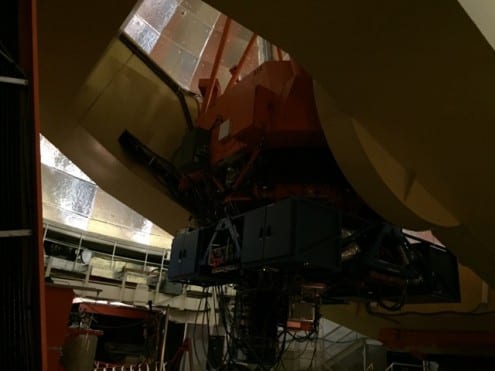
Inside the NASA Infrared Telescope Facility. Photo: Patrick Owen
Having prepared and calibrated everything and chosen our first standard star to use as a check for everything, the Telescope Operator said “no”.
Apparently it’s 100% humidity outside and it is lovely and misty.
We had a slight tease at about midnight: we got as far as opening the telescope dome and finding our standard star. Alas, just as we started taking actual measurements the humidity shot back up and we had to close the dome.
Night 3
There’s a massive difference when we get up to the summit tonight! Stars! I can see stars, not particularly brightly, which is mostly to do with the lack of oxygen at this altitude meaning my eyes aren’t working as well as they should, but stars!

NASA Infrared Telescope Facility at night. Photo: NASA
If I can see stars, the telescope can see stars. After some changing of instruments and refilling of coolants (no mean feat at that altitude) we were finally ready to get started. We found and observed out standard star without much of an issue.
Then we started looking for the little “knots” of gas we are observing in the Crab Nebula. This took us a while longer than planned, but we got there and all lined up on the instrument so we could get the data we need. Nothing. Tried again. Nothing. By this time it was also about 3am, the combination of the time and the lack of oxygen made this all rather difficult to cope with.

The Crab Nebula is full of knots and filaments of gas. Photo: NASA/ESA/Hester/Loll/Barlow
We set the telescope to run for a two hour run to see if we could get anything at all. Other than some cosmic rays (really not what we’re looking for at all) we got… nothing. Frustration and worry about our calculations and whether what we were doing was right ensued. I paced. Lots. As the sun came up I went outside to get some fresh air (and see the telescopes, I’d only been up here in the dark until now), before heading down to the base camp for some fried food and sleep.
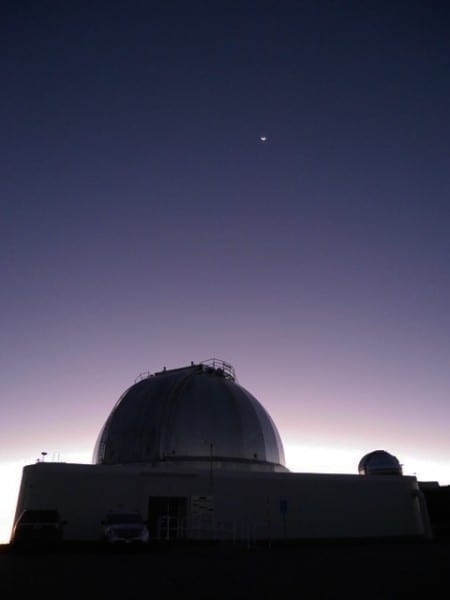
The telescope at dawn, with crescent moon. Photo: Patrick Owen
Night 4
I woke up this “morning” to an email telling me that there had been something wrong with the instrument. Good news as it means we’re probably going to get some good data this evening. Bad news because it was a really simple fix that had we known about it would have allowed us to get some good data last night too.
Ah well, onwards and upwards. After another slog to get set up and find a new brighter standard star and things, we got observing.
Final night lucky, at about half past three, we finally realised we’d found what we were looking for! Massive amounts of relief all round, we still had to finish the run and get as much data as we could before the sun came up, but we got some.
It’ll take several weeks of processing the data followed by several more weeks of analysis before we know exactly what we have.
That can wait until after I’ve finished writing my thesis.

Sunset from base camp. Photo: Patrick Owen
Patrick Owen is a PhD student in UCL Physics & Astronomy, and has recently returned from observing in Hawaii
Scientific advice on cutting your Christmas cake
By Oli Usher, on 18 December 2014
Francis Galton was a pioneer of genetics and heredity (if you like him) or eugenics (if you don’t). He was also Charles Darwin’s cousin. Although Galton never worked at UCL, he was close to the institution, in particular as a close collaborator of Karl Pearson, the founder of UCL’s statistics department. Galton left his collections to the college on his death in 1911.
He was unquestionably brilliant, but also a problematic figure, particularly by today’s standards. In his partial defence, the term ‘eugenics’ – which he coined – was far less loaded in his time than it is today. The depravity of the Third Reich was yet to come, and the worst abuses of European colonialism were not widely known. Both, of course, were rooted in the ‘scientific’ racism of eugenics. Moreover, things which are quite uncontroversial today, such as contraception, were considered to be part of eugenics.
But for good reasons, he remains controversial.
Galton was a polymath, working across disciplinary boundaries and making contributions to many areas of knowledge. One of his more offbeat proposals is reproduced above: a letter to Nature, proposing a new and efficient way of cutting cakes, based on ‘scientific principles’. ‘Scientific principles’ in this case appear to mean avoiding the cut surfaces drying out, no matter how ridiculous the method turns out to be.
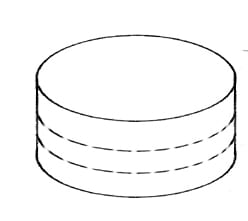
Here at the UCL Science blog, we think his work on cake is like his work on heredity: historically interesting, but contentious.
We would also like to propose a more efficient way of slicing a cake, which like Galton’s, avoids the surfaces drying out, but unlike Galton’s, requires no elastics and produces equally-sized and shaped slices: cut the cake horizontally.
Merry Christmas.
Tip of the hat to Prof Joe Cain.
 Close
Close




